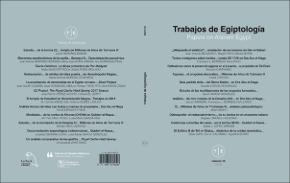Textos e imágenes sobre textiles de la dinastía XXII de la tumba UE 1018 en Dra Abu el-Naga
Date
2019Abstract
Durante las campañas de 2017 y 2018 del Proyecto Djehuty en Dra Abu el-Naga ha sido documentado, en una tumba de inicios del Reino Medio reutilizada, el enterramiento de varios individuos vinculados al sacerdocio y la Casa de Amón en la dinastía XXII. Entre los artefactos hallados destaca un conjunto de textiles. Un primer grupo incluye los títulos y nombre del propietario junto con un año de reinado. En otro, a diferencia del anterior, sólo se consignan los cargos y la identidad de sus propietarios. En tercer lugar, hay marcas y signos de lavandería o tejeduría de algunas de las piezas de los tipos anteriores y de otras que sólo incluyen esa clase de notación. Además, entre las piezas que con seguridad formaron parte del ajuar funerario hay dos grupos de artefactos: sudarios con una figura de Osiris de gran tamaño y textos anejos referidos a la deidad y al propietario de la mortaja y estolas con extremos de cuero y escenas donde un rey ofrenda ante una deidad. El análisis y la contextualización preliminar de estos testimonios permiten conocer mejor el perfil social y las prácticas funerarias de los individuos enterrados en el área de Dra Abu el-Naga durante el Tercer Periodo Intermedio. In 2017 and 2018, the Proyecto Djehuty has documented in a tomb of the early Middle Kingdom at Dra Abu el-Naga the burial of several individuals linked to the priesthood and the Domain of Amun of the Twenty-Second Dynasty. Among the artefacts found there, a group of textiles stands out. A first group includes the name and titles of the owner along with a year of reign. In another, unlike the previous one, only the titles and the identity of their owners are recorded. Thirdly, there are marks and signs of laundry or weaving in some of the pieces of the preceding types and others that only include a similar kind of notation. In addition, among the objects that formed part of the burial goods are two groups of artefacts: shrouds with a large figure of Osiris and texts referring to the deity and its owner and braces with leather ends where a king is offering before a deity. The analysis and preliminary contextualization of this evidence allow for a better understanding of the social profile and funeral practices of the individuals buried in Dra Abu el-Naga in the Third Intermediate Period.





